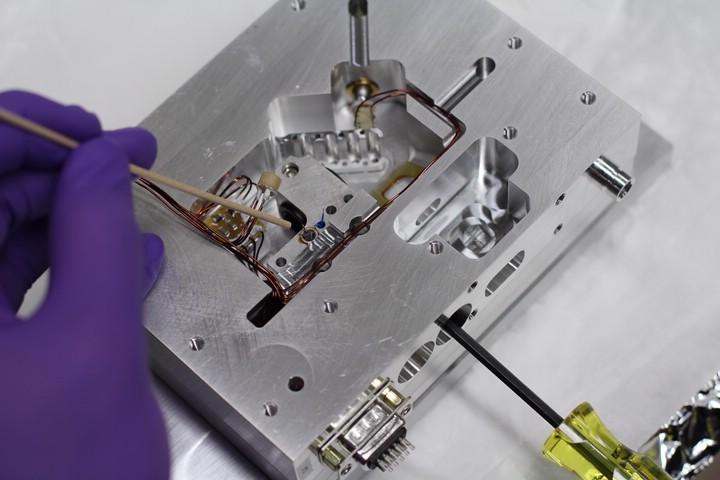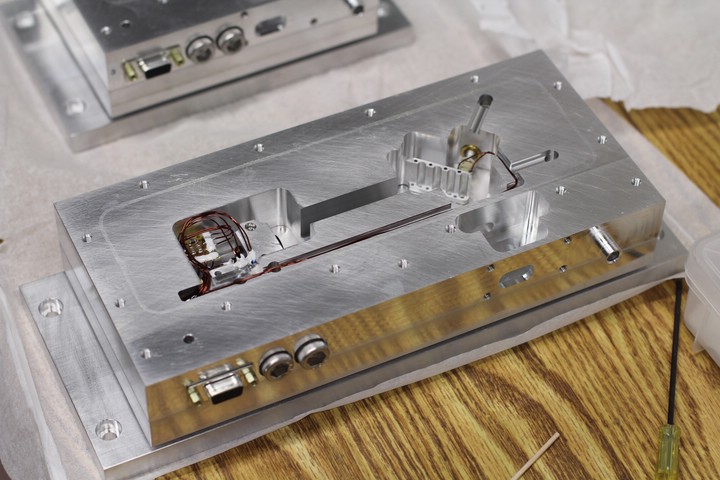Unibody Littrow Laser
Steck Lab
Department of Physics
University of Oregon
541.346.5863
Page last updated Nov. 2, 2012
Overview
A Littrow configuration external cavity diode laser. Features include:
- Main cavity constructed from a single aluminum block
- Noise reduction features: decreased length and mass of grating arm, (rough) vacuum compatibility, use of non-rectangular geometries to avoid cavity resonances
- Easily modified for other wavelengths; easily altered cavity length
- Designed to use low cost, readily available parts
- Machined parts easily constructed on a CNC milling machine
- Integrated beam shaping, optical isolation, and fiber coupling
In creating this design, we made conscious efforts to optimize the cavity's
stability at the expense of simple large-scale tunability. The result is a
laser that works well for atomic physics—although we don't have
mode-hop-free tuning over much more than 10 GHz, the free-running laser
is quite immune to environmental perturbations.
For a more complete description and stability investigations, see our RSI paper.
Assembly Photos
We have photographically detailed and discussed the assembly process
here.



Altering cavity length and operating wavelength
The right-angle geometry of our design allows a simple elongation of the
Littrow cavity, and we made a short and long version of otherwise
identical lasers.
Extending the cavity length decreases the white noise contribution to the
linewidth (by a
factor of the square of the ratio of the lengths), but also decreases the free
spectral range of the cavity, substantially reducing the mode-hop-free
tunability of the laser. We recommend using the long cavity design
only when you desire an unusually narrow linewidth
(typical atomic transitions are broader than a few hundred kHz anyway,
so it's just not worth the extra headache).
We have successfully constructed lasers at several wavelengths (994, 922,
914, 780, and 689 nm), but the geometry supports an assortment of
wavelength ranges.
For more information on adapting this design to your particular wavelength,
we have made
this page.
Machine Drawings
Download a complete set of all materials listed below:
(All ZIP)
Note that the Diode Can Mount and Optical Isolator Mounts are identical for the long and short lasers. They are included in both machine drawing sets for convenience.

- Short cavity laser
This original version of our cavity has a length (2.15 cm)
that is typical of home-built ECDLs.

- Long cavity laser
Using the right-angle geometry of our design we easily
lengthened the cavity to 10 cm. The cavity resolution is
increased while mechanical stability is maintained, resulting
in a narrower laser linewidth.
Peripherals
Components common to both cavity types.
- DB-15 Connector (Male)
(Datasheet PDF)
(Pinout PDF)
(Pinout VWX)
Note that we connect the current supply ground to the connector shell
(and thus laser body) to mitigate ground loop issues
- Homemade temporary grating positioner
(Drawing)
- Homemade support for epoxying Brewster window, diffraction grating, and potting wires
(we use a laser cutter to construct this from 3/8" plywood)
(VWX Drawing)
(Adobe Illustrator for laser cutter)
- 23AWG Heavy-Build Polyimide ML Magnet Wire
(MWS Wire Industries)
- Thorlabs LT230P-B Diode Collimation Tube
(Product Page)
(Datasheet PDF)
- Appropriate socket for laser diode (ex:
Thorlabs S8060 for 3-pin, 9 mm diode)
- EPCOS B57861S0503F040 Thermistor
(Datasheet PDF)
- AD590 Temperature Sensor
- Internal Circuit Board, simplified for compactness from a
previous version.
(PDF for etching)
(Osmond PCB file)
(gerber.zip)
We etch the circuit onto a double-sided copper board from Circuit
Specialists
(P/N GD101)
Requires the following components:
1x 1206 package capacitor, 0.1uF
1x 1206 package capacitor, 1.0nF
1x 1206 package resistor, 10 ohm
1x 1206 package Murata ferrite bead (EMI filter), Mouser P/N 81-BLM31A700S
1x SOD-323 package 1N5711 schottky diode, Mouser P/N 621-1N5711WS-F
- Noliac Piezomechanical Actuator SCMAP02
(Datasheet PDF)
- Swiss Jewel Model W7.87 Sapphire Windows
(Swiss Jewel)
- Laird 56460-501 Thermoelectric Cooler
(Datasheet PDF)
- Epo-Tek 353ND
(Datasheet PDF)
- Torr-Seal or similar vacuum epoxy, we used Loctite Hysol 1C
(Datasheet PDF)
- Brewster Window (Microscope Slide)
- Fabry-perot laser diode from you favorite diode vendor, AR-coated
if you like
- Newport Holographic Diffraction Gratings (Special Order)
(Datasheet PDF)
6x12x3.2mm
Wavelength Specific
Gold Coated for longer wavelengths
- Thorlabs PS871-B Anamorphic Prisms
(Datasheet PDF)
(Guide)
(Code and other files)
- Viton O-Ring McMaster-Carr Part: 9464K104 Model: AS568A-004 (5/64" ID x 13/64" OD)
(Catalog)
- Oz Optics Fiber Coupler
(Datasheet PDF)
- Seal-Off Valve
(Instructions)
(Datasheet)
(VWX Drawing)
(Valve Operator)
- Screws, Washers, etc.




